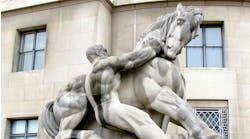BY ROBERT P. MADER
Of CONTRACTOR’s staff
HOUSTON — It would tough to ask for a better rivalry. When the NFL’s expansion Houston Texans played their first official game this month, it was against the Dallas Cowboys. And it would be tough to ask for a better stadium to play it in than Houston’s new Reliant Stadium. How many pro teams have an indoor pool near their locker room?
In August contractors were frantically finishing punch list items leading up to the stadium’s official opening Aug. 18.
Reliant Stadium is also the only NFL venue with a retractable fabric roof. Cowboys fans were quick to note that Texas Stadium has a hole in the roof so God can see his favorite team play, so it was appropriate that the Texans would be covered up.
Mechanical contractor Letsos Co. started the design-assist phase back in February 2000, said CEO James Letsos. His phase of construction started in August 2000.
When the roof is closed the entire stadium is air-conditioned, even the seating bowl. With the roof open, everything else is still cooled, with positive pressure in the concourses keeping the humidity out even though they are open to the seating area.
A central plant constructed by Sempra Energy provides hot and chilled water to Reliant Stadium, the nearby Astrodome and a new convention center. Reliant Energy is operating the plant. The plant delivers 200°F hot water and 38°F chilled water.
The water runs through 24-in. pipe into the building where it’s circulated by four 300-hp Armstrong chilled water pumps and three 100-hp hot water pumps.
Letsos installed 55 Trane air-handling units delivering more than 1.7 million cfm and 13,000-14,000 tons of cooling. More than 500 Krueger terminal boxes distribute the air. Letsos also installed 37 fan coil units in the electrical room to cool off transformers and junction boxes.
The contractor installed 16 air-handling units in each end zone because, as Letsos noted, the end zones are the least-desirable seating areas. The end zone mechanical rooms were constructed from the outside with the equipment lifted in by cranes, then enclosed later.
The air-handlings units move the air through 66-in. round duct that’s hung in the bowl area from the bar joists, which support the fabric roof structure.
Washington state-based AccuDuct Manufacturing Co. set up a fab shop in the parking lot and produced the duct on site. The duct, fabricated in 10-ft. lengths, was rolled into the stadium in special trailers. The duct was then moved to a specially built platform on the third level of the stadium and hoisted more than 200 ft. in the air to the bar joists. The hoisting was done by Upstage Center, a rigger whose usual work entails rigging concert speakers in arenas.
The ductwork was attached to the bar joist with 3/8-in. cable. All the joints were flanged and gasketed with the grille openings welded in place. All the grille openings had to be positioned correctly to follow the engineer’s computer-modeled airflow analysis.
Letsos also installed 66-in. smoke exhaust duct. The exhaust duct feeds into the four “super-columns” that support the building. The super-columns are concrete box columns 30-in. thick and hollow in the middle. A 100,000-cfm smoke exhaust fan draws smoke through each column.
In all, Letsos installed 2.2 million lb. of sheet metal.
A Siemens building automation system controls the HVAC system. Encompass Services was the electrical contractor.
Because the installation of the super columns was a scheduling priority, plumbing contractor Har-Con Corp. could not do the below grade work first, noted project manager Jim Brewer.
Har-Con plumbed nearly 100 toilet rooms, 1,000 toilets total, using Toto commercial fixtures and Toto manual piston-type flush valves. The only automatic flush valves are in the “jail” in the lower level for people who need to be detained by security. The Symmons lavatories are equipped with Zurn faucets.
Brewer’s crew also plumbed the locker rooms with Symmons shower valves. He noted that the showerheads are mounted 78 in., or higher in some cases, off the floor.
Water is supplied by city water that goes into two 10,000-gal. surge tanks. Only the first level is served by city water pressure. The rest of the stadium is handled by a booster system with two jockey pumps and six 600-gpm water pumps. Domestic hot water comes from the central plant, run through three heat exchangers that Har-Con installed.
All the concession stands have their own water heaters, which are 100-gal. A.O. Smith electric units.
Har-Con also installed the roof drainage system. Rainwater will run off the fabric roof onto “super-trusses” (connected to the super-columns) and into 40 roof drains on each side of the building.
The rainwater will flow through four 26-in. risers and into a 30-in. main that feeds into the city storm sewer system. The risers are galvanized steel joined with Victaulic fittings.
The stadium is protected by a variety of wet, dry and pre-action sprinkler systems, said Don Marritt, project manager for Casteel Automatic Fire Protection. City water feeds into a surge tank and is fed through the system by a 2,500-gpm fire pump at 150 psi.
Most of the systems are wet systems except for freezers and computer rooms, Marritt noted, and most are black iron pipe. His crew installed as many as 25,000 Central Sprinkler heads.

